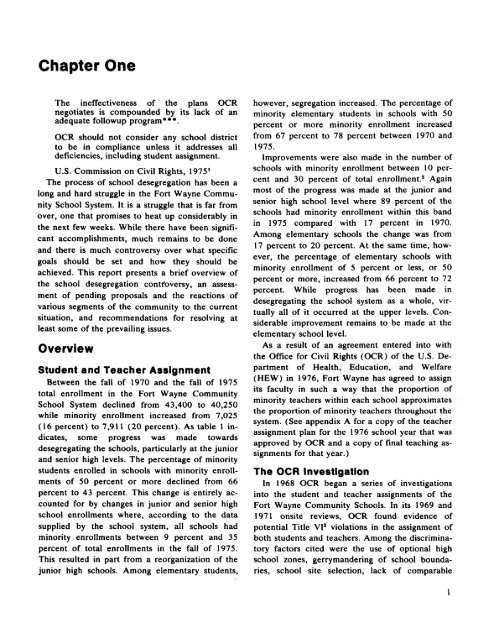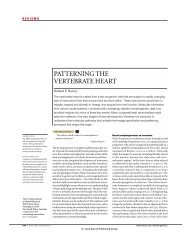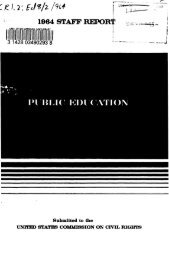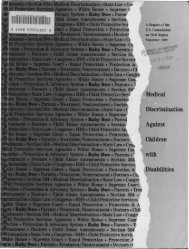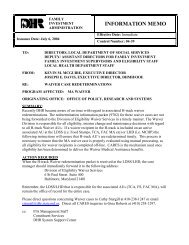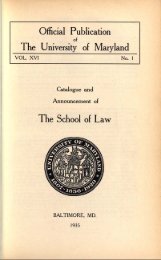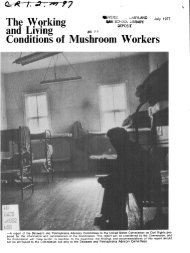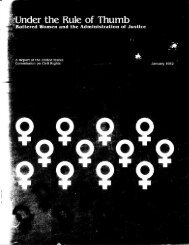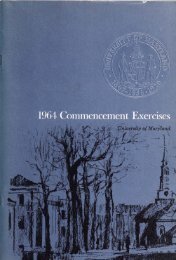Equal Opportunity in the Fort Wayne Community Schools: A ...
Equal Opportunity in the Fort Wayne Community Schools: A ...
Equal Opportunity in the Fort Wayne Community Schools: A ...
You also want an ePaper? Increase the reach of your titles
YUMPU automatically turns print PDFs into web optimized ePapers that Google loves.
Chapter OneThe <strong>in</strong>effectiveness of <strong>the</strong> plans OCRnegotiates is compounded by its lack of anadequate followup program***.OCR should not consider any school districtto be <strong>in</strong> compliance unless it addresses alldeficiencies, <strong>in</strong>clud<strong>in</strong>g student assignment.U.S. Commission on Civil Rights, 1975 1The process of school desegregation has been along and hard struggle <strong>in</strong> <strong>the</strong> <strong>Fort</strong> <strong>Wayne</strong> <strong>Community</strong>School System. It is a struggle that is far fromover, one that promises to heat up considerably <strong>in</strong><strong>the</strong> next few weeks. While <strong>the</strong>re have been significantaccomplishments, much rema<strong>in</strong>s to be doneand <strong>the</strong>re is much controversy over what specificgoals should be set and how <strong>the</strong>y should beachieved. This report presents a brief overview of<strong>the</strong> school desegregation contfoversy, an assessmentof pend<strong>in</strong>g proposals and <strong>the</strong> reactions ofvarious segments of <strong>the</strong> community to <strong>the</strong> currentsituation, and recommendations for resolv<strong>in</strong>g atleast some of <strong>the</strong> prevail<strong>in</strong>g issues.OverviewStudent and Teacher AssignmentBetween <strong>the</strong> fall of 1970 and <strong>the</strong> fall of 1975total enrollment <strong>in</strong> <strong>the</strong> <strong>Fort</strong> <strong>Wayne</strong> <strong>Community</strong>School System decl<strong>in</strong>ed from 43,400 to 40,250while m<strong>in</strong>ority enrollment <strong>in</strong>creased from 7,025(16 percent) to 7,911 (20 percent). As table 1 <strong>in</strong>dicates,some progress was made towardsdesegregat<strong>in</strong>g <strong>the</strong> schools, particularly at <strong>the</strong> juniorand senior high levels. The percentage of m<strong>in</strong>oritystudents enrolled <strong>in</strong> schools with m<strong>in</strong>ority enrollmentsof 50 percent or more decl<strong>in</strong>ed from 66percent to 43 percent. This change is entirely accountedfor by changes <strong>in</strong> junior and senior highschool enrollments where, accord<strong>in</strong>g to <strong>the</strong> datasupplied by <strong>the</strong> school system, all schools hadm<strong>in</strong>ority enrollments between 9 percent and 35percent of total enrollments <strong>in</strong> <strong>the</strong> fall of 1975.This resulted <strong>in</strong> part from a reorganization of <strong>the</strong>junior high schools. Among elementary students,however, segregation <strong>in</strong>creased. The percentage ofm<strong>in</strong>ority elementary students <strong>in</strong> schools with 50percent or more m<strong>in</strong>ority enrollment <strong>in</strong>creasedfrom 67 percent to 78 percent between 1970 and1975.Improvements were also made <strong>in</strong> <strong>the</strong> number ofschools with m<strong>in</strong>ority enrollment between 10 percentand 30 percent of total enrollment. 2 Aga<strong>in</strong>most of <strong>the</strong> progress was made at <strong>the</strong> junior andsenior high school level where 89 percent of <strong>the</strong>schools had m<strong>in</strong>ority enrollment with<strong>in</strong> this band<strong>in</strong> 1975 compared with 17 percent <strong>in</strong> 1970.Among elementary schools <strong>the</strong> change was from17 percent to 20 percent. At <strong>the</strong> same time, however,<strong>the</strong> percentage of elementary schools withm<strong>in</strong>ority enrollment of 5 percent or less, or 50percent or more, <strong>in</strong>creased from 66 percent to 72percent. While progress has been made <strong>in</strong>desegregat<strong>in</strong>g <strong>the</strong> school system as a whole, virtuallyall of it occurred at <strong>the</strong> upper levels. Considerableimprovement rema<strong>in</strong>s to be made at <strong>the</strong>elementary school level.As a result of an agreement entered <strong>in</strong>to with<strong>the</strong> Office for Civil Rights (OCR) of <strong>the</strong> U.S. Departmentof Health, Education, and Welfare(HEW) <strong>in</strong> 1976, <strong>Fort</strong> <strong>Wayne</strong> has agreed to assignits faculty <strong>in</strong> such a way that <strong>the</strong> proportion ofm<strong>in</strong>ority teachers with<strong>in</strong> each school approximates<strong>the</strong> proportion of m<strong>in</strong>ority teachers throughout <strong>the</strong>system. (See appendix A for a copy of <strong>the</strong> teacherassignment plan for <strong>the</strong> 1976 school year that wasapproved by OCR and a copy of f<strong>in</strong>al teach<strong>in</strong>g assignmentsfor that year.)The OCR InvestigationIn 1968 OCR began a series of <strong>in</strong>vestigations<strong>in</strong>to <strong>the</strong> student and teacher assignments of <strong>the</strong><strong>Fort</strong> <strong>Wayne</strong> <strong>Community</strong> <strong>Schools</strong>. In its 1969 and1971 onsite reviews, OCR found evidence ofpotential Title VI 3 violations <strong>in</strong> <strong>the</strong> assignment ofboth students and teachers. Among <strong>the</strong> discrim<strong>in</strong>atoryfactors cited were <strong>the</strong> use of optional highschool zones, gerrymander<strong>in</strong>g of school boundaries,school site selection, lack of comparable1


